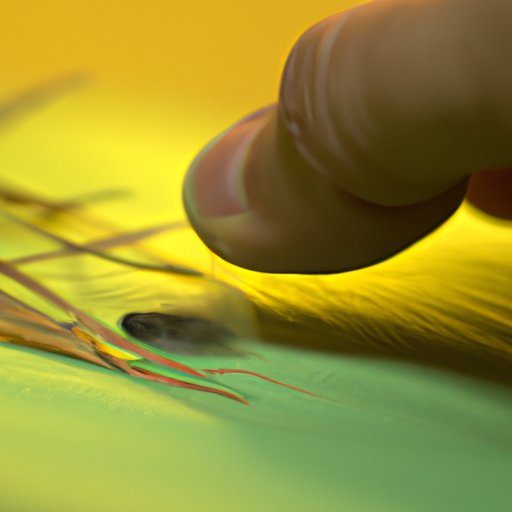Introduction
If you have ever found holes or damage on your clothes, carpets, or blankets, then you might have a moth problem. Moths are small, pesky insects that can quickly infest your home and ruin your fabrics and textiles. It’s essential to address the problem as soon as possible to prevent further damage and ensure the health and safety of your family. In this article, we will explore several effective methods for getting rid of moths.
Natural remedies
One of the first options for getting rid of moths is using natural remedies. These methods do not involve harsh chemicals and are often safe for people and pets. Cedar wood and lavender are two effective natural repellents that many people swear by. Cedar wood has oils that repel moths, and lavender has a naturally strong scent that moths don’t like. Placing sachets of cedar wood or lavender in your wardrobe or closet will help keep moths away.
Another option is freezing clothes or other infested items for several days. This will kill any eggs or larvae present, preventing them from multiplying. You can also vacuum spaces like closets or storage boxes to remove any moths that are hiding. Additionally, pheromone traps can be a useful tool for getting rid of moths. These traps use chemicals that lure in male moths, preventing them from mating and creating more offspring.
The benefits of using natural remedies are that they are generally safe, cost-effective, and straightforward to implement. However, these remedies may not eradicate the problem entirely and may require more time and effort than other alternatives.
Pesticides
If natural remedies don’t seem to be solving the problem, then using insecticides might be the next step. Insecticides are pesticides that are specially formulated to kill moths and other insects. Before applying any insecticides, it’s crucial to choose the right one for the problem at hand. Some insecticides are specifically for moths, while others are designed for other pests. Make sure to read the label and follow the instructions carefully.
When applying insecticides, it’s important to consider safety concerns. Insecticides can be toxic and harmful to pets and people, so it’s crucial to use them carefully. Wear protective gear like gloves and a mask when applying insecticides and follow instructions carefully. Additionally, make sure to keep pets and children away from the treated area until it’s safe to re-enter.
Professional treatments
If the infestation is severe, it may be necessary to hire a professional exterminator to get rid of moths. There are several professional treatments available, including fumigation, heat treatment, and insecticide spray. Fumigation involves enclosing the infested area and releasing a gas that kills all moths and their larvae. Heat treatment works by applying high temperatures to the affected area, killing all moths and their offspring. Insecticide spray is a targeted method of killing moths and is applied to areas where moths are present.
The cost, effectiveness, and ease of use of each treatment vary. Fumigation is often the most expensive but also the most thorough way of eliminating moths. Heat treatment can be effective but requires specialized equipment. Insecticide spray is typically the cheapest and easiest to use but may not be as effective in severe infestations.
Prevention methods
Preventing moth infestations is essential to avoid any future damage. One of the most effective ways to prevent moths is by using mothballs, which release a strong scent that moths dislike. Another method is to seal any entryways like windows or doors that moths could use to enter your home. Changing the fabric of your clothes to synthetic fibers or regularly washing them can also help prevent moth infestations.
Taking these preventative measures can save time, money, and effort in the long term. It’s best to be proactive and try to prevent moth infestations from occurring in the first place.
DIY moth repellents
DIY moth repellents are another effective way of getting rid of moths. Vinegar, peppermint oil, and lemon are all household materials that can create a strong scent that moths dislike. Mixing these materials in a spray bottle and applying it to the affected area can help repel moths. These DIY methods are often cost-effective, eco-friendly, and straightforward to implement.
Comparing moth traps
Moth traps are another option for getting rid of moths. There are several different types of traps available, including sticky traps and pheromone traps. Sticky traps use a glue-like surface to trap moths, and pheromone traps use chemicals to lure in male moths, preventing them from mating. When comparing moth traps, consider their cost, effectiveness, and ease of use.
The benefits of moth traps are that they are often very effective and easy to use. However, they may not be as thorough as other methods and may also need to be replaced periodically.
Getting rid of larvae
Getting rid of moth larvae is crucial to completely eliminating the problem. Finding moth larvae can be challenging, but they often leave behind strings of silk or webbing. Once found, it’s essential to safely dispose of them and prevent them from hatching. Freezing, boiling, or microwaving infested items can kill larvae and prevent them from spreading.
Conclusion
In summary, getting rid of moths involves several effective methods, including natural remedies, pesticides, professional treatments, preventative measures, DIY methods, moth traps, and getting rid of larvae. It’s important to choose the best option for each situation and prioritize methods that are safe, effective, and cost-efficient. By taking the necessary steps to get rid of moths, you can help protect your clothes, textiles, and home from further damage.
